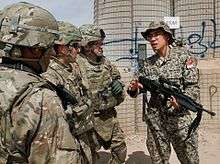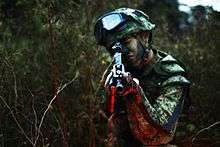SAR 21
The SAR 21 ("Singapore Assault Rifle - 21st Century") is a bullpup assault rifle designed and manufactured in Singapore. First revealed and subsequently adopted by the Singapore Armed Forces (SAF) in 1999, it was designed and developed over a four-year period and was intended to replace the locally license-built M16S1[3] by the Ministry of Defence (MINDEF), Singapore Army and the Chartered Industries of Singapore (CIS, now ST Kinetics).[4] Many of its design features are directly intended to counter the weaknesses of the M16S1 as encountered operationally by some infantrymen.[1]
| SAR 21 | |
|---|---|
.png) SAR 21, right side view. Pictured SAR 21 is attached with the Round Corner Firing (RCF) module and has had its magazine removed. | |
| Type | Bullpup assault rifle |
| Place of origin | Singapore |
| Service history | |
| In service | 1999–present[1] |
| Used by | See Users |
| Production history | |
| Designer | Tuck Wah Chee and Felix Tsai of Chartered Industries of Singapore (now ST Kinetics)[2] |
| Designed | 1996[1] |
| Manufacturer | • CIS: 1999–2000[1] • ST Kinetics: 2000–present[1] |
| Produced | 1999–present[1] |
| Variants | See variants |
| Specifications | |
| Mass | • SAR 21: 4 kg (8.82 lb)[1] • SAR 21 GL/M203: 5.3 kg (12 lb) • SAR 21 P-Rail: 3.6 kg (7.9 lb) • SAR 21 MMS: 3.5 kg (7.7 lb) • SAR 21 Light Weight Carbine 3 kg (6.6 lb) |
| Length | 805 mm (31.7 in) (SAR 21, SAR 21 40 GL/M203, SAR 21 P-Rail) 680 mm (26.8 in) (SAR 21 MMS) 640 mm (25.2 in) (SAR 21 Light Weight Carbine) |
| Barrel length | 508 mm (20.0 in)[1] |
| Cartridge | 5.56×45mm NATO[1] |
| Caliber | 5.56 mm (0.22 in)[1] |
| Barrels | Single barrel 1:12" and 1:7" twist options [3] |
| Action | Gas-operated, rotating bolt |
| Rate of fire | 450–650 rounds/min[1] |
| Muzzle velocity | 970 m/s (3,182 ft/s) (M193) 945 m/s (3,100.4 ft/s) (SS109) |
| Effective firing range | 460 m (M193) 800 m (SS109) |
| Feed system | 30-round detachable plastic box magazine Export models: STANAG magazines[3] |
| Sights | 1.5x or 3x optical sight; back-up iron sights |
The rifle is being sold for export use aside from domestic use.[5] In the United States, it was marketed by ST Kinetics via its American subsidiary, VT Systems.[6]
The SAR 21 would be replaced in production in the near future by the BR18.[7]
History and development
Since the mid-80s, the SAF had an outstanding requirement to come up with a replacement for their M16S1 as most of these had been in use since 1973, in part due to limitations that Singapore cannot export the M16S1 or make new assault rifles based on it.[8] In 1994, a proposal by SAF was submitted to the MINDEF for options to either procure newer weapons (thought was given to purchase the M16A2) or to develop its own indigenous rifle.[9] On 19 November 2002, a patent was filed with the United States Patent and Trademark Office by Tuck Wah Chee and Felix Tsai with the patent number 6,481,144 B1.[2]
MINDEF officials, after consultations with the SAF, decided against buying weapons off the shelf as it would require soldiers to adjust to the new weapon, choosing instead to develop a weapon, designed and made specifically for ease of use by the conscript soldiers of the SAF, who are mostly of slighter physiques. Coupled with the rising costs of maintaining the M16S1s in SAF's armory, this made it even more justifiable to develop a low-maintenance weapon.[1]
The rifle was in Indian news when an audit was made on whether criminal charges should be filed against ex-Ordnance Factory Board director Sudipta Ghosh for improperly declaring a partnership with STK over supplying Indian law enforcement with the SAR 21 Modular Mounting System.[10]
Design

The SAR 21 is made of a rugged, high impact polymer, most of the manufacturing is done utilising CNC machines, with ultrasonic welding for the steel-reinforced receiver halves and the gun barrel being cold hammer forged.[8] It uses a modified Stoner operating system, boasting higher reliability and lower recoil.[8] The translucent magazine allows precise assessment of current ammo load.[9]
The SAR 21 is also the first production assault rifle of its class to incorporate a built-in Laser Aiming Device[4] (powered by a single "AA-size" battery) as standard.[8] It has a 5 position switch which can emit a visible beam at high or low power. It can also be set to "steady on" or "momentary on" which is triggered with the use of a pressure switch activated with the user's left thumb.[11] The rifle incorporates various patented safety features, such as a Kevlar cheek plate and overpressure vent that protects the shooter in the event of a chamber explosion or catastrophic failure.[3][12]
It also has an integral 1.5x optical scope that is built into its carrying handle (A 3.0x version is also available). The scope aids in target acquisition, particularly under low light conditions. The scope is factory-zeroed, and requires minimal further zeroing to suit different users.[3][4] This minimizes non-training range time.[1]
Design issues
Early users of the weapon in the Singapore Armed Forces experienced many problems due to their unfamiliarity with the bullpup design. Their criticisms (usually in comparison with the M16S1 rifles they were already trained with) include:
- the awkward position of the magazine well, and the difficulty in changing magazines, requiring multiple hand changes due to its bullpup shape
- the awkward position of the fire selector (located at the butt, with the action), as opposed to the thumb selector on the M16S1[9][13]
- the sluggish trigger pull compared with the crisp trigger of the M16S1
- the weight of the weapon
- the increased muzzle blast, due to the muzzle being nearer to the user's ears
- being told by instructors that it is a "right-handed only" weapon and left-handed soldiers having to (and are still being taught to) fire with their right hand
- iron sights that chip off easily when weapon is dropped
- Lack of internal illumination of the scope (the crosshairs in the scope are virtually invisible in the dark)
Some of these criticisms were addressed with design modifications to the later production models. New weapon handling procedures were also introduced.
- The magazine changing issue was solved with training soldiers to always hold the pistol grip with their master hand. The charging of the weapon and reloading of magazines are to be done by the non-master hand.
- The sluggish trigger pull was improved by using a stiff sliding plate in place of the flexible rod.
- The Steyr AUG styled iron sights were replaced with stockier, hardier ones.
The Kevlar plating on the left side of the weapon butt (where a right-handed user's face would typically be) is effective in protecting the user from any internal chamber explosion by directing the resulting force to the right.[8] However, that resultant force would also seriously injure anyone unfortunate enough to be on the right side of the weapon. In the case of a user firing from his or her left shoulder, this could cause severe injury to his or her face. As a result, all left-handed SAF soldiers are taught to fire from their right shoulder as a safety measure. The SAR 21 was designed with a small in-built brass deflector to eject spent bullet casings forward, thus reducing the chances of the spent casings hitting a left-handed user's face. This means the rifle is not completely ambidextrous but may, in a pinch, be fired from the left shoulder.[1]
Operation

Like the M16 rifle, the bolt locks open on an empty magazine. When the magazine is exhausted, it is removed by depressing the AK-style lever. Clearing the weapon is accomplished by removing the magazine, pulling the charging handle to the rear, and observing the chamber. After loading a magazine into the housing, the weapon is made "ready" by cocking the weapon, and engaging the FN MAG-type safety button forward of the trigger guard. The position of the fire selector button (SEMI or AUTO) on the stock may also be adjusted.[1]
The on/off switch for the laser aiming device is located on the left handguard; when holding the weapon at ready, the left thumb rests naturally on it.[8] With sluggish operation due to fouling, the gas regulator setting may be increased by turning it with a coin, screwdriver, or any other thin flat object. Alternatively, the gas regulator can be unlatched and turned by hand with aid of the knurled surface.[1]
Variants
- SAR 21 Light Machine Gun (LMG)
- Fitted with an open bolt, it has a heavy 513 mm (20.2 in) barrel with an integral folding bipod and a foregrip.[1]
- SAR 21 Sharpshooter
- Same as the basic SAR 21, but has 3.0x optical sight instead of standard 1.5x sight. The sight picture is composed of luminous black paint, allowing easier target engagement at night without use of the LAD.[3]
- SAR 21 Grenade Launcher (GL)
- Attached with a CIS 40 GL or M203 grenade launcher.[3][11] Several sub-variants/prototypes incorporate different targeting modules (or mounted on p-rails) for grenade target acquisition. Known sights to have been used include aiming quadrants, various optical sights and laser fire control systems.[3]
- SAR 21 Picatinny rail
- Has a Picatinny rail in place of its integral optical sight.[11] Charging handle is moved to the left hand side of the weapon (Interchangeable with right side).[3][11]
- SAR 21 Modular Mounting System (MMS)
- Has integral optical sight and LAD removed to allow a wide variety of add-on tactical accessories, such as vertical assault grips, tactical lights and reflex sights. Charging handle is moved to the left hand side of the weapon.[11] Similar to P-rail model with exception of shorter barrel.[3][11] Variants consist of a standard and carbine-based barrels.[14]
- SAR 21 Lightweight Carbine
- A lightweight SAR 21 variant was revealed during the Asian Defence Exhibition held in conjunction with 2006 Asian Aerospace. The variant boasts an ultra-short barrel and shorter handguards. A Picatinny rail is used as well.[3]
- RCF module
- The Round Corner Firing (RCF) module, similar in concept to the Israeli CornerShot, can be attached to any of the above SAR 21 variants for conducting operations in an urban environment.[15]
- SAR 21A
- The prototype was unveiled at the Singapore Air Show 2010, this updated variant boasts sturdier thumb selector for ambidextrous control, an unloaded weight of 3.2 kg (7 lb 0.9 oz), a full built-in Picatinny rail along its length and a higher rate of firing at 900 RPM. In production as of 2012.[16]
Users








References
- Notes
- Richard J, 2008.
- "United States Patent Chee et a." Retrieved 24 July 2010.
- "SAR 21 Product Brochure" (PDF). ST Engineering. Archived from the original (PDF) on 4 November 2013. Retrieved 24 July 2010.
- "Factsheet - Singapore Assault Rifle 21". Singaporean Ministry of Defence (MINDEF). Archived from the original on 25 December 2012. Retrieved 24 July 2010.
- "Infantry Article Index". 19 November 1999. Archived from the original on 22 February 2012. Retrieved 24 July 2010.
- "Call to arms in Singapore yields explosive results". Fairfax Digital. 3 August 2003. Archived from the original on 5 January 2010. Retrieved 24 July 2010.
- https://www.gunsweek.com/en/rifles/articles/st-kinetics-br18-ultimate-bull-pup-assault-rifle
- "Archived copy". Archived from the original on 2 August 2018. Retrieved 2 August 2018.CS1 maint: archived copy as title (link)
- Charles Q Cutshaw (31 May 2000). "Singapore is rearing SAR 21 bullpup rifle for home and export requirement". Jane's International Defence Review: Land Forces News. Archived from the original on 25 February 2008. Retrieved 29 October 2010.
- https://www.stratpost.com/anatomy-of-a-blacklist-singapore-technologies/
- "Singapore Technologies Kinetics SAR-21 assault rifle (Singapore)". Archived from the original on 9 August 2010. Retrieved 24 July 2010.
- "SAR 21". Popular Mechanics. Archived from the original on 27 January 2010. Retrieved 24 July 2010.
- David Crane (16 March 2004). "SAR-21 Bullpup Assault Rifle: World's Best Combat Bullpup?". Defense Review. Archived from the original on 21 July 2010. Retrieved 24 July 2010.
- "Archived copy" (PDF). Archived from the original (PDF) on 4 November 2013. Retrieved 23 July 2013.CS1 maint: archived copy as title (link)
- "Factsheet: Urban Operations". MINDEF. 25 July 2006. Archived from the original on 3 March 2016. Retrieved 17 May 2013.
- "New Assault Rifle from ST Kinetics - The Firearm Blog". The Firearm Blog. Archived from the original on 10 November 2014. Retrieved 23 December 2014.
- Binnie, Jeremy; de Cherisey, Erwan (2017). "New-model African armies" (PDF). Jane's. Archived from the original (PDF) on 22 June 2017.
- Mahmud, Hadi DP (20 February 2008). "RBTS and STK ink MoU deal for vehicle upkeep". The Brunei Times. Archived from the original on 27 February 2009. Retrieved 24 July 2010.
- Daniel Watters. "The 5.56 X 45mm: 2007". GunZone.Com. Archived from the original on 10 October 2008. Retrieved 24 July 2010.
- "Weapon". Archived from the original on 23 December 2014. Retrieved 23 December 2014.
- "Factsheet - Singapore Assault Rifle 21". MINDEF. 19 May 2005. Archived from the original on 25 December 2012. Retrieved 29 April 2013.
- Bibliography
- Richard Jones; Andrew White (2008). Jane's Guns Recognition Guide. HarperCollins. p. 316. ISBN 978-0-00-726645-6.
External links
| Wikimedia Commons has media related to SAR-21. |